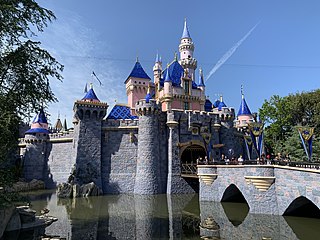
Anaheim is a city in northern Orange County, California, United States, part of the Greater Los Angeles area. As of the 2020 census, the city had a population of 346,824, making it the most populous city in Orange County, the tenth-most populous city in California, and the 56th-most populous city in the United States. The second largest city in Orange County in terms of land area, Anaheim is known for being the home of the Disneyland Resort, the Anaheim Convention Center, and two professional sports teams: the Los Angeles Angels of Major League Baseball (MLB) and the Anaheim Ducks of the National Hockey League (NHL). It also served as the home of the Los Angeles Rams of the National Football League (NFL) from 1980 through 1994.

Hollywood and Vine, the intersection of Hollywood Boulevard and Vine Street in Hollywood, California, became known in the 1920s for its concentration of radio and movie-related businesses. The Hollywood Walk of Fame is centered on the intersection.

The Disneyland Resort is an entertainment resort in Anaheim, California, United States. It is owned and operated by the Walt Disney Company through its Experiences division and is home to two theme parks, three hotels, and the Downtown Disney shopping, dining, and entertainment district.

Downtown Disney is a lifestyle center located at the Disneyland Resort in Anaheim, California, United States. It opened on January 12, 2001; a component of the Disneyland Resort expansion project alongside the Disney California Adventure theme park and Disney's Grand Californian Hotel & Spa.
The Paseo is an outdoor mall in Pasadena, California, covering three city blocks with office space, shops, restaurants, a movie theater, and 400 loft-style condominiums above.
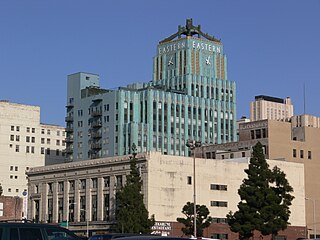
The Historic Core is a district within Downtown Los Angeles that includes the world's largest concentration of movie palaces, former large department stores, and office towers, all built chiefly between 1907 and 1931. Within it lie the Broadway Theater District and the Spring Street historic financial district, and in its west it overlaps with the Jewelry District and in its east with Skid Row.
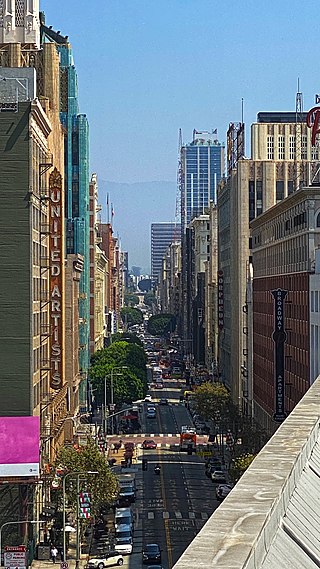
Broadway, until 1890 Fort Street, is a major thoroughfare in Los Angeles County, California, United States. The portion of Broadway from 3rd to 9th streets, in the Historic Core of Downtown Los Angeles, was the city's main commercial street from the 1910s until World War II, and is the location of the Broadway Theater and Commercial District, the first and largest historic theater district listed on the National Register of Historic Places (NRHP). With twelve movie palaces located along a six-block stretch, it is the only large concentration of movie palaces left in the United States.
The Broadway was a mid-level department store chain headquartered in Los Angeles, California. Founded in 1896 by English-born Arthur Letts Sr., and named after what was once the city's main shopping street, the Broadway became a dominant retailer in Southern California and the Southwest. Its fortunes eventually declined, and Federated Department Stores bought the chain in 1995. In 1996, Broadway stores were either closed or converted into Macy's and Bloomingdales, some of which were sold and converted to Sears, including the Stonewood Center and Whittwood Town Center locations.
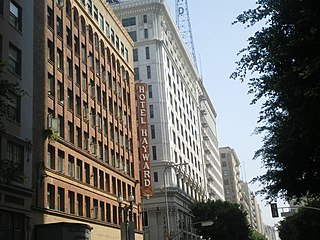
Spring Street in Los Angeles is one of the oldest streets in the city. Along Spring Street in Downtown Los Angeles, from just north of Fourth Street to just south of Seventh Street is the NRHP-listed Spring Street Financial District, nicknamed Wall Street of the West, lined with Beaux Arts buildings and currently experiencing gentrification. This section forms part of the Historic Core district of Downtown, together with portions of Hill, Broadway, Main and Los Angeles streets.
Main Street is a major north–south thoroughfare in Los Angeles, California. It serves as the east–west postal divider for the city and the county as well.

The Anaheim Packing House is a 42,000-square-foot (3,900 m2) gourmet food hall in Downtown Anaheim, California, United States. Along with the Packard Building, a renovated 1925 Mission Revival style building, and a farmer's market, it makes up a shopping center called the Anaheim Packing District. The Packing House opened on May 31, 2014, and is located in a renovated 1919 former Sunkist citrus packing house built in Spanish Colonial Revival style. It is one of the few remaining packing houses in Orange County, and the only one in Anaheim. The packing house was added to the National Register of Historic Places as the Anaheim Orange and Lemon Association Packing House in 2015.
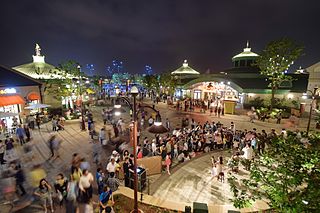
Disneytown is a shopping, dining, and entertainment complex at the Shanghai Disney Resort in Pudong, Shanghai, China. It is the largest attraction of the resort outside of the parks, featuring many original and licensed market experiences. It is the Shanghai equivalent of other Disney Parks' major shopping centers, such as Downtown Disney. Unlike the Shanghai Disneyland park, Disneytown does not require a ticket to enter.
The following is a timeline of the history of the city of Anaheim, California, US.

M. Eugene Durfee (1885-1941) was an American architect prominent in Orange County, California.

Walker Scott, also Walker-Scott or Walker's, was a chain of department stores in San Diego and surrounding area from 1935 to 1986 and had eight branches at the time of its closure. It was founded by Ralf Marc Walker and George A. Scott.
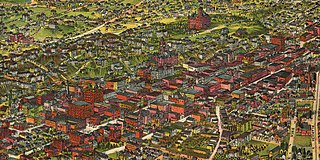
The late-Victorian-era Downtown of Los Angeles in 1880 was centered at the southern end of the Los Angeles Plaza area, and over the next two decades, it extended south and west along Main Street, Spring Street, and Broadway towards Third Street. Most of the 19th-century buildings no longer exist, surviving only in the Plaza area or south of Second Street. The rest were demolished to make way for the Civic Center district with City Hall, numerous courthouses, and other municipal, county, state and federal buildings, and Times Mirror Square. This article covers that area, between the Plaza, 3rd St., Los Angeles St., and Broadway, during the period 1880 through the period of demolition (1920s–1950s).

7th Street is a street in Los Angeles, California running from S. Norton Ave in Mid-Wilshire through Downtown Los Angeles. It goes all the way to the eastern city limits at Indiana Ave., and the border between Boyle Heights, Los Angeles and East Los Angeles.

Retail in Southern California dates back to its first dry goods store that Jonathan Temple opened in 1827 on Calle Principal, when Los Angeles was still a Mexican village. After the American conquest, as the pueblo grew into a small town surpassing 4,000 population in 1860, dry goods stores continued to open, including the forerunners of what would be local chains. Larger retailers moved progressively further south to the 1880s-1890s Central Business District, which was later razed to become the Civic Center. Starting in the mid-1890s, major stores moved ever southward, first onto Broadway around 3rd, then starting in 1905 to Broadway between 4th and 9th, then starting in 1915 westward onto West Seventh Street up to Figueroa. For half a century Broadway and Seventh streets together formed one of America's largest and busiest downtown shopping districts.
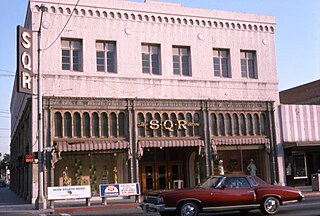
The SQR Store, a.k.a. S.Q.R. Store, later simply SQR, was a department store in Downtown Anaheim, California, one of the largest in Orange County of its time. SQR stood for August E. Schumacher (1881–1948), Wesley P. Quarton and Oscar H. Renner.

















